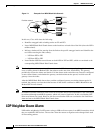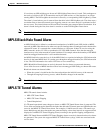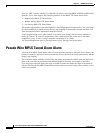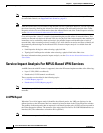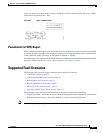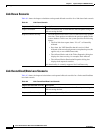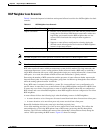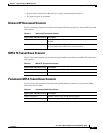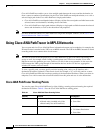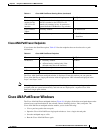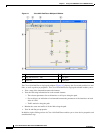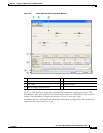
8-6
Cisco Active Network Abstraction 3.6.6 MPLS User Guide
OL-19192-01
Chapter 8 Impact Analysis in MPLS Networks
Supported Fault Scenarios
Figure 8-2 Route Reflector Example
In the example, the following configuration is applied:
• Router A (router ID A) has clients configured B, C, and D. Therefore it serves as the route reflector
for these BGP routers.
• Routers B, C, and D all have Router A as a BGP non-client neighbor.
• Router D and Router B also have each other configured as BGP non-client neighbors.
In this case, in Cisco ANA, the following information is maintained by a VNE:
• Router B learns router ID D from interface 1.
• Router B learns router IDs A, C, and D from interface 2.
• Router C learns router IDs A, B, and D from interface 1.
• Router D learns router ID B from interface 2.
• Router D learns router IDs A, B, and C) from interface 1.
• Router A learns router ID D from interface 1.
• Router A learns router ID C from interface 2.
• Router A learns router ID B from interface 3.
In the Figure 8-2 example, if a BGP connection is lost from Router A to Router B, the following occurs:
• Router A notifies both Routers C and D of the loss of router ID B.
• Router C removes the ID of Router B from its tables and completely loses connectivity to it,
resulting in a Real Affected impact analysis.
• Router D loses the ID of Router B learned from interface 1, but it still has Router B’s ID that was
learned through interface 2. Therefore, no impact analysis is performed.
If a BGP connection is lost from Router B to Router D, the following occurs:
• Router B does not notify Router A of its router ID loss, because Router A is configured in Router
B’s tables as a non-client peer.
• Router D does not notify Router A of its router ID loss, because Router A is configured in Router
D’s tables as a non-client peer.
• Router B notes that the ID of Router D is no longer learned through interface 1.
IF 1
IF 1
IF 1
IF 1
IF 3
IF 2
IF 2
IF 2
Router A
(RR)
Router BRouter D
Router C
154564



